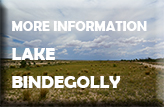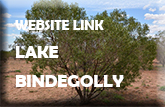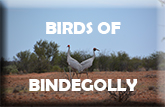Lake Bindegolly National Park
About Lake Bindegolly
Park alerts
No current alerts for this park. See alerts for all parks
Getting there and getting around

View across Lake Bindegolly, one of a string of salt and freshwater wetlands within Lake Bindegolly National Park. Photo: Karen Smith © Queensland Government
Lake Bindegolly map (PDF, 83K)
Lake Bindegolly is 150km west of Cunnamulla, or 40km east of Thargomindah, on the Bulloo Developmental Road (Adventure Way).
To protect the fragile lake edges and samphire flats, vehicles are not allowed on the park. Park your vehicle at the shelter near the bridge and walk to the lakes.
Wheelchair accessibility
There are no wheelchair-accessible tracks or facilities at Lake Bindegolly.
Park features

Lake Bindegolly National Park conserves one of the most important wetland systems in south-west Queensland. Photo: Karen Smith © Queensland Government
Gnarled wattles standing above a low shrub layer break the burnt orange slopes leading down to a series of glistening lakes. Lake Bindegolly National Park conserves one of the most important wetland systems in south-west Queensland.
A string of lakes—Bindegolly, Toomaroo and Hutchinson—are found in Lake Bindegolly National Park. Several unnamed freshwater lakes are also found on private property to the south of the park. Although each lake is a separate basin, they join to form a ribbon of water after heavy rainfall in local catchments. At times thousands of waterbirds flock to this inland oasis to feed and to breed.
The diverse 14,000ha Lake Bindegolly National Park also has samphire flats, claypans, sand dunes, hard and soft red mulga country, gidgee woodlands, and Eremophila shrublands. The park was established in 1991 to protect the Acacia ammophila tree which grows along the sand dunes fringing the eastern side of the lakes. This is one of only two known populations of this gnarled tree which is threatened with extinction.
On the western side of the lake, Mulga-studded gibber plains rise to a ridge known locally as Mt Bindegolly.
- Read more about the nature, culture and history (https://parks.des.qld.gov.au/parks/lake-bindegolly/culture.html) of Lake Bindegolly National Park.
Camping and accommodation
Camping
Camping is not permitted in the national park. However, nearby camping is permitted on the southern side of the Bulloo Development Road (Adventure Way), but there are no facilities.
Other accommodation
Holiday accommodation is available at nearby Thargomindah. For more information see the tourism information (on this page) links below.
Things to do

Rest spot and sign on Lake Bindegolly circuit walk. Photo: Karen Smith © Queensland Government

Huge numbers of waterbirds can be seen on the lakes. Image courtesy of Robert Ashdown
Drive to the park entrance and read about the park’s wildlife and history at the display in the picnic shelter. Have a picnic or walk to the lake. Take your binoculars and go birdwatching. See wildflowers in spring.
Walking
Key to track standards
The classification system is based on Australian Standards. Please note that while each track is graded according to its most difficult section, other sections may be easier.
 Grade 4 track
Grade 4 track
- May be extensively overgrown; hazards such as fallen trees, holes and rocks likely to be present.
- Moderate level of fitness required.
- Ankle-supporting footwear strongly recommended.
 Lake Bindegolly Circuit—9.2km return (allow 3 hours)
Lake Bindegolly Circuit—9.2km return (allow 3 hours)
Explore around Lake Bindegolly, skirting the lake edge then returning via scrub-covered sandhills. Follow the markers and stay on the sandy track to protect the park’s fragile vegetation. Wear a hat and sunscreen and take water. Note: sections of the walking track may be covered by water when the lake is full.
Viewing wildlife
Extensive lakes and wetlands make Lake Bindegolly ideal for birdwatching. At times thousands of waterbirds flock to the lake to feed and breed. Birds commonly seen on the lake include pelicans, swans and a variety of waders. Wedge-tailed eagles, blue bonnets, pink cockatoos and mulga parrots are birds of the shrublands. Watch for reptiles and for red and grey kangaroos which come to drink at the lakes.
Walk rather than drive near the lakes and you will see more birds and preserve fragile ecosystems. A bird viewing site is 4.5km from the car park. Early mornings are best for seeing and photographing arid zone wildlife. See the description of the park's natural environment for more details about Lake Bindegolly’s diverse wildlife.
Fishing
Fishing and boating are not permitted.
Things to know before you go

During dry times Lake Bindegolly can become a vast, white saltpan. Photo: Mark Handley © Queensland Government

Usually only the main lakes in the park contain water, but in exceptionally wet years the lakes join to form a continuous body of water from north to south. Photos: Mark Handley © Queensland Government

Fresh water flowing into the Bindegolly lakes sets off a 'boom and bust' cycle of life, where a rapid increase in shrimp and other invertebrates is followed by a rise in fish numbers and birds keen to take advantage of the sudden food.
Essentials to bring
- Carry adequate supplies of food, water, fuel, vehicle spares and medical supplies.
- Prepare for an extra four or five days in case you become stranded due to flooding.
- Rubbish bins are not provided. Please bring rubbish bags, and take all recyclables and rubbish with you when you leave.
- Bring your camera and binoculars for viewing wildlife.
Opening hours
Lake Bindegolly National Park is open 24 hours a day.
Pets
Domestic animals are not permitted in Lake Bindegolly National Park.
Climate and weather
The cooler months of the year, from April to September, are the best times to visit.
During July, the average maximum temperature is 19°C, while overnight temperatures can fall to a frosty -5°C. Clear winter nights ensure magnificent starry skies. In summer, daytime temperatures often exceed 40°C.
Lake Bindegolly is in the semi-arid rangelands and has a low, variable rainfall and a high rate of evaporation. More than half the average annual rainfall of 276mm falls during summer.
After good rains (whether in the local area or far upstream), flooding isolates the park from nearby townships for long periods.
For more information see the tourism information (on this page) links below.
Fuel and supplies
Fuel and supplies are available at Thargomindah, Eulo and Cunnamulla. For more information see the tourism information (on this page) links below.
Staying safe

A black-faced woodswallow hawks for insects above the samphire. Photo courtesy of Robert Ashdown
Your safety is our concern, but your responsibility. For your safety ensure that you:
- Carry adequate supplies of food, water, fuel, vehicle spares and medical supplies.
- Wear a hat, sunscreen, comfortable clothes and sturdy shoes.
- Always carry drinking water and a first-aid kit when walking.
- Avoid walking in the hottest part of the day, especially in warmer months.
- Inform a responsible person where you are going and when you will be back.
In an emergency
In case of accident or other emergency call Triple Zero (000).
Mobile phone coverage is not available in Lake Bindegolly National Park.
Satellite phones can be used at Lake Bindegolly National Park. Consider taking a Personal Locator Beacon (PLB). If you have a PLB, it should only be activated in a serious emergency situation, when there is no alternative way to raise assistance.
The Royal Flying Doctor Service operates in this area. For more information that will help you enjoy a safe visit to this area, please read the guidelines Safety in parks and forests (https://parks.des.qld.gov.au/experiences/safety_in_parks_and_forests.html).
Looking after the park

The lake margins and samphire flats within Lake Bindegolly are extremely fragile. Photo courtesy of Robert Ashdown
Please help preserve this park's exceptional natural and cultural values by following these few common sense rules:
- Leave everything as you find it. This includes plants, animals, rocks and artefacts.
- No boating or fishing is allowed on the lakes.
- The lakes' margins and samphire flats are extremely fragile. Stay on established tracks and obey all road signs. Careless driving off the tracks will result in long-term scarring of these areas.
- Leave your pets at home. Pets frighten wildlife, annoy other visitors, can become lost and are prohibited in the park.
- Firearms and other weapons must not be used in national parks.
- Use a fuel stove to boil your billy.
- Never contaminate lakes and rivers with detergents, soap, shampoos or human waste.
- Bury toilet waste at least 15cm deep and 150m from any watercourse or lake. Toilet paper is slow to break down in arid areas, so please burn toilet paper if it is safe to do so.
- Please remove your rubbish when you leave. Do not bury or burn. Buried rubbish provides food for wildlife and feral animals.
See Caring for parks (https://parks.des.qld.gov.au/experiences/caring_for_parks_and_forests.html) for more information about protecting our environment and heritage in parks.
Park management
Formerly a grazing property, Lake Bindegolly National Park was declared in 1991 to protect the Acacia ammophila trees and conserve representative samples of landscapes, vegetation and wildlife in the Mulga Lands Biogeographic Region.
The Queensland Parks and Wildlife Service manage Lake Bindegolly National Park under the Nature Conservation Act 1992.
Tourism information links

The fragile ecosystems of Lake Bindegolly National Park require careful ongoing management. Photo: Robert Ashdown © Queensland Government
Contact the information centres below for more information about activities, tours and accommodation in this region.
Cunnamulla Visitor Information Centre
www.paroo.info (https://www.paroo.info/)
Centenary Park, Jane Street, Cunnamulla, QLD 4490
ph (07) 4655 8470
fax (07) 4655 1120
email cunnamullainfo@paroo.qld.gov.au
Thargomindah Visitor Information Centre
www.thargotourism.com.au (http://www.thargotourism.com.au/)
Eccles Street, Thargomindah, QLD 4490
ph (07) 4655 3399
fax (07) 4655 3374
email thargo.info@bigpond.com
For tourism information for all regions in Queensland see Queensland Holidays (http://www.queensland.com/).
Check with the Department of Transport and Main Roads (https://qldtraffic.qld.gov.au/) or call 13 19 40 for local and main road conditions before setting out.



